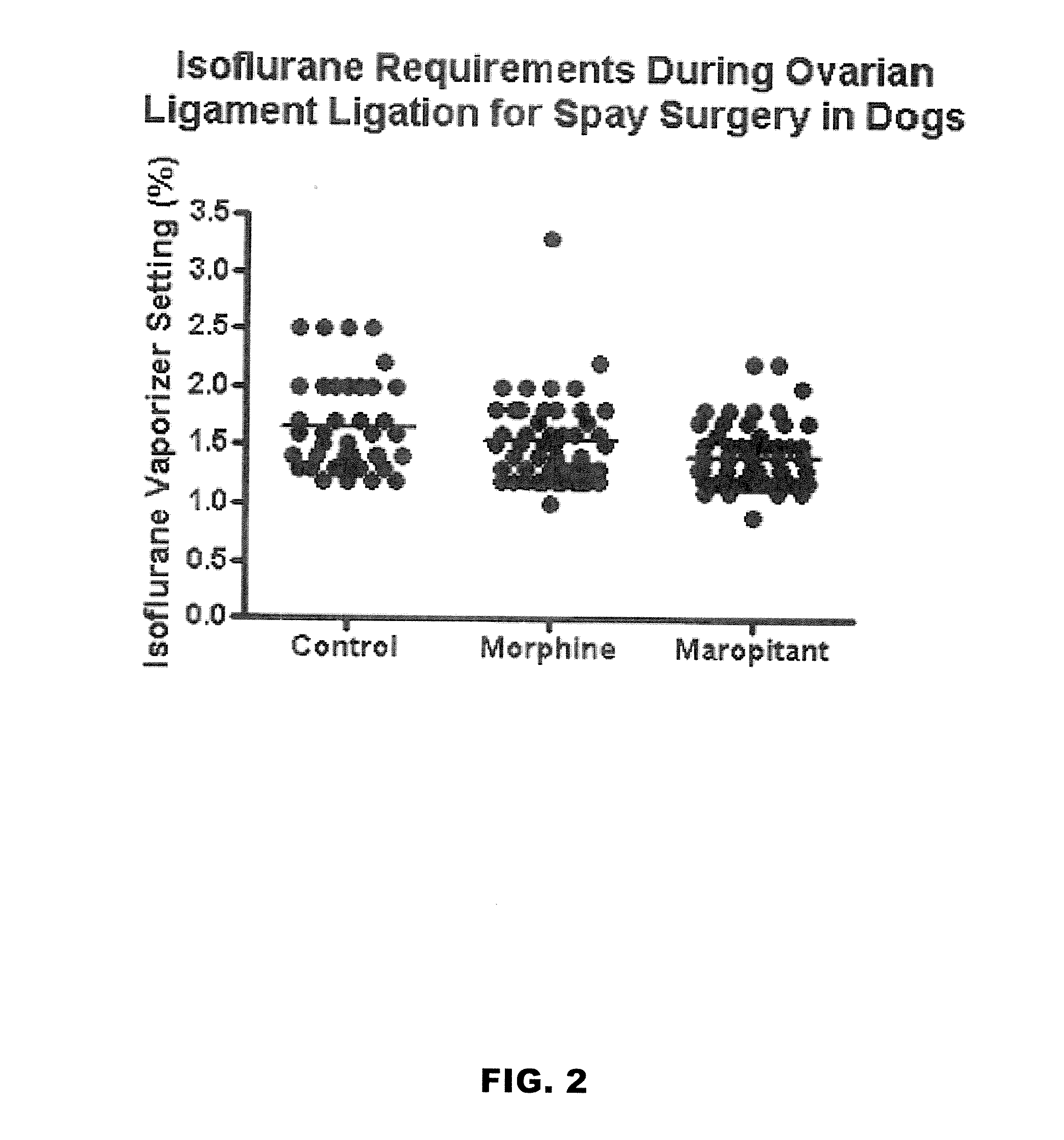Use of nk-1 receptor antagonists in management of visceral pain
a technology of nk-1 receptor and visceral pain, which is applied in the field of pain management, can solve the problems of opioid abuse risk in the clinic, reduced vascular resistance, and high cost of volatile anesthetics, and achieve the effect of improving visceral analgesia
- Summary
- Abstract
- Description
- Claims
- Application Information
AI Technical Summary
Benefits of technology
Problems solved by technology
Method used
Image
Examples
example 1
Maropitant Decreases the Sevoflurane MAC During Visceral Stimulation in Dogs
[0053]The NK1 receptor antagonist maropitant, available as Cerenia® from Pfizer, is an antiemetic approved for use in dogs. The ability of maropitant to impact the sevoflurane minimum alveolar concentration (MAC) level needed for surgery was tested in canine subjects. The eight animals were 1 year old, intact female, Walker hound mix. A first group was administered 1 mg / kg maropitant, I.V. over 5 minutes then 30 μg / kg / h. A second group was administered 5 mg / kg maropitant, I.V. over 5 minutes then 150 μg / kg / h. General anesthesia was induced using sevoflurane as described below and otherwise according to standard veterinary procedure. Animals were maintained in dorsal recumbency. MAC reduction effect was tested by stimulation of the ovarian ligament. Ovariectomy was performed on each animal at the end of the study.
[0054]In each animal, sterile laparoscopy was performed to access the right ovary. Following thir...
example 2
Maropitant Induced Analgesia and Comfort in Dogs During and After Spay Surgery
[0056]Having shown as described in Example 1 that maropitant has visceral analgesic and anesthetic sparing properties in dogs, including the effect of increasing the pain threshold during anesthesia by 24-30%, a follow up clinical trial was conducted to test the analgesic effect of maropitant in dogs during spay surgery (laparotomy ovariohysterectomy). The maropitant analgesic effect was directly compared with the analgesic effect elicited by morphine, a standard common analgesic used in human and veterinary medicine.
[0057]Forty (40) female dogs were admitted in the clinical trial and divided into three groups for comparison: a control, a maropitant and a morphine group. Dogs in the control group received 0.1 ml / kg SQ of sterile physiologic saline before anesthesia. Dogs in the morphine group received 0.5 mg / kg of morphine SQ before anesthesia for pain management. Dogs in the maropitant group received 1 mg...
example 3
Maropitant Decreases the Sevoflurane Mac During Visceral Stimulation in Cats
[0064]Maropitant is the first candidate analgesic with antiemetic properties for cats. No adverse effects such as constipation, diarrhea, gastric ulcers, liver toxicity or renal failure have been reported while using maropitant in cats at the recommended clinical doses, while such complications have been described when other analgesics are used in cats. Accordingly, the use of maropitant to promote analgesia in cats during ovarian ligament stimulation was also investigated. Following the results obtained in dogs as described in the previous examples, anesthetic requirements were expected to decrease in cats when maropitant is administered, if maropitant has comparable analgesic properties in cats.
[0065]Ten (10) female cats were anesthetized with sevoflurane. Following stabilization, the right ovarian ligament was accessed using a laparoscopic approach to determine the anesthetic minimum alveolar concentratio...
PUM
| Property | Measurement | Unit |
|---|---|---|
| body weight | aaaaa | aaaaa |
| weight | aaaaa | aaaaa |
| vascular resistance | aaaaa | aaaaa |
Abstract
Description
Claims
Application Information
 Login to View More
Login to View More - R&D
- Intellectual Property
- Life Sciences
- Materials
- Tech Scout
- Unparalleled Data Quality
- Higher Quality Content
- 60% Fewer Hallucinations
Browse by: Latest US Patents, China's latest patents, Technical Efficacy Thesaurus, Application Domain, Technology Topic, Popular Technical Reports.
© 2025 PatSnap. All rights reserved.Legal|Privacy policy|Modern Slavery Act Transparency Statement|Sitemap|About US| Contact US: help@patsnap.com



